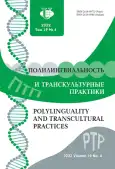From Intercultural Communication to Transcultural Creativity: A Study of Russian-American Fiction
- Authors: Lebedeva E.S.1
-
Affiliations:
- Lomonosov Moscow State University
- Issue: Vol 19, No 4 (2022)
- Pages: 685-693
- Section: LITERARY SPACE
- URL: https://journal-vniispk.ru/2618-897X/article/view/326736
- DOI: https://doi.org/10.22363/2618-897X-2022-19-4-685-693
- ID: 326736
Cite item
Full Text
Abstract
The world has been growing more globalised, people have been moving and absorbing different cultural peculiarities. Now intercultural perspective might seem insufficient to describe the extent to which local cultures and identities are linked globally. As a result, language contact and communication between and across cultures have been changing. The present paper aims at studying modern RussianAmerican fiction from intercultural and transcultural perspectives emphasizing the translingual features and transcultural changes. The paper discusses the phenomenon of creative translingualism, which means writing in one or two languages that are not the native tongues. Contemporary American literature may be proud of its modern writers of Russian and Soviet descent: Olga Grushin, Sana Krasikov, Lara Vapnyar, Anya Ulinich, Irina Reyn. All the authors changed their country of birth and moved to the USA and as a result, they chose English as the language of their creative writings. However, the English of their works reflects the Russian language, culture, and identity of the writers making the English text not truly English. The research primarily studies the linguistic tools (borrowing, code mixing, code-switching and broken English) used by the writers to render Russian culture by means of the English language as well as the transcultural shift that has been inevitable and has become an inalienable part of new cultural identities.
About the authors
Ekaterina S. Lebedeva
Lomonosov Moscow State University
Author for correspondence.
Email: chaton17@mail.ru
Senior Lecturer, Faculty of Foreign Languages and Area Studies, Department of Foreign Languages Theory 31/1, Lomonosovskyi , Moscow, 119192, Russian Federation
References
- Proshina, Z.G. 2017. Translingualism and its application. RUDN Journal of Language Education and Translingual Practices 14 (2): 155-170. doi: https://doi.org/10.22363/2312-8011-2017-142-155-170
- Guilherme, M., and G. Dietz. 2015. Difference in diversity: multiple perspectives on multicultural, intercultural, and transcultural conceptual complexities//Journal of Multicultural Discourses 10 (1): 1-21. doi: http://dx.doi.org/10.1080/17447143.2015.1015539
- Zhukova, I.N., and M.G. Lebedko, Z.G. Proshina, N.G. Yuzefovitch. 2013. Slovar terminov mezhkulturnoi kommunikatsii [Terminological Dictionary of Intercultural Communication]. Moscow: FLINTA: Nauka publ. Print. (in Russ.)
- Bennett, M. 2013. Ethnocentrism/Xenophobia. Entry in: C. Cortes (Ed.) Multicultural America: A multimedia encyclopedia. New York: Sage. Print.
- Kecskes, I. 2018. How does intercultural communication differ from intra-cultural communication? Curtis, Andy and Roland Sussex (eds.) Intercultural Communication in Asia: Education, Language and Values. Cham: Springer. 115-135. doi https://doi.org/10.1007/978-3-319-69995-0_7
- Rosado, C. 1996. Toward a Definition of Multiculturalism, 1996. Publ. Web https://www.academia.edu/777187/Toward_a_Definition_of_Multiculturalism
- Baker, W. 2020. Exploring intercultural and transcultural communication in ELT. The Center for EFL Journal 6: 1-10. doi: https://doi.org/10.15045/ELF_0060101
- Nordin, I.G., and J. Hansen, C.Z. Llena. 2013. Transcultural Identities in Contemporary Literature. Amsterdam - New York: Rodopi. Print.
- Pennycook, A. 2007. Global Englishes and Transcultural Flows. New York: Routledge.
- Welsch, W. 1999. Transculturality-The Puzzling Form of Cultures Today, in: M. Featherstone, S. Lash (Eds.), Spaces of Culture: City, Nation, World. London: Sage: 194-213. doi: http://dx.doi.org/10.4135/9781446218723.n11
- Ting-Toomey, S. 1999. Communicating Across Cultures. New York: Guilford.
- Canagarajah, S. Translingual Practice: Global Englishes and Cosmopolitan Relations. New York: Routledge. Print.
- Pennycook, A. 2008. Translingual English. Australian Review of Applied Linguistics 31(3): 301-309 doi: https://doi.org/10.2104/aral0830.
- Hudson, R.A. 1996. Sociolinguistics, 2nd edition. Cambridge University Press.
- Reyn, I. 2008. What happened to Anna K. New York: Touchstone. Print.
- Krasikov, S. 2009. One more year. New York: SPIEGEL & GRAU. Print.
- Wanner, A. 2019. Triple Identities: Russian-Speaking Jews as German, American, and Israeli Writers. In Z. Gitelman (Ed.) The New Jewish Diaspora. New Brunswick: Rutgers University Press: 286-298. doi: https://doi.org/10.36019/9780813576312-021
- Vapnyar, L. 2007. Memoirs of a Muse. New York: Vintage. Print.
- Grushin, O. 2007. The Dream life of Sukhanov. New York: Penguin. Print.
- Grushin, O. 2016. Forty Rooms. New York: G.P. Putnam’s sons. Print.
- Bhatia, T.K., and W.C. Ritchie. 2004. The Handbook of Bilingualism. New Jersey: Blackwell Publishing. Print.
- Mikheyev, D. 1987.The Soviet Mentality. Political Psychology 8(4): 491-523. doi: https://doi.org/10.2307/3790919
Supplementary files









